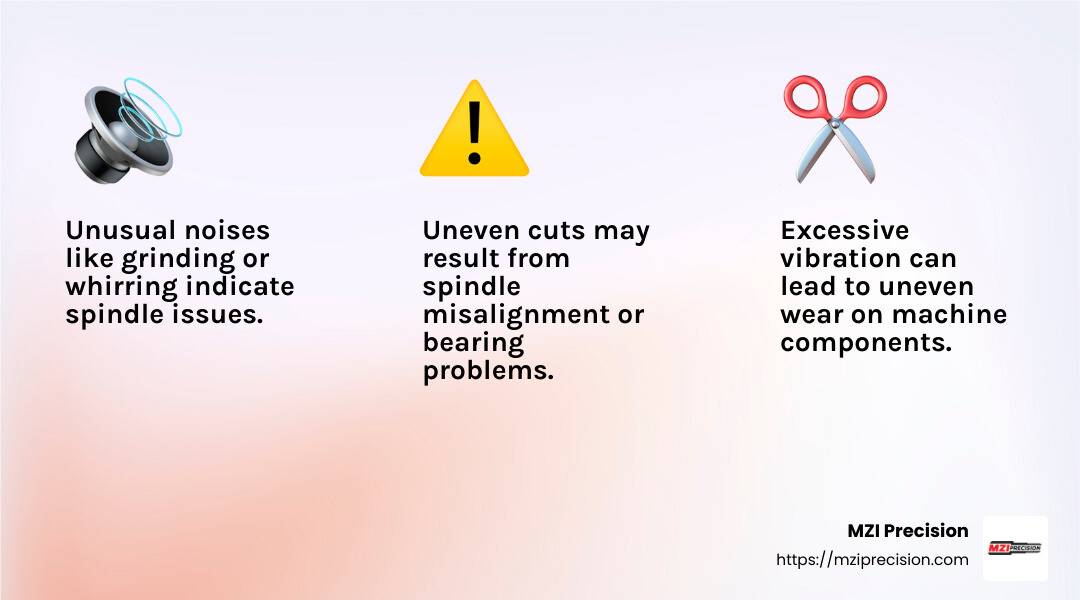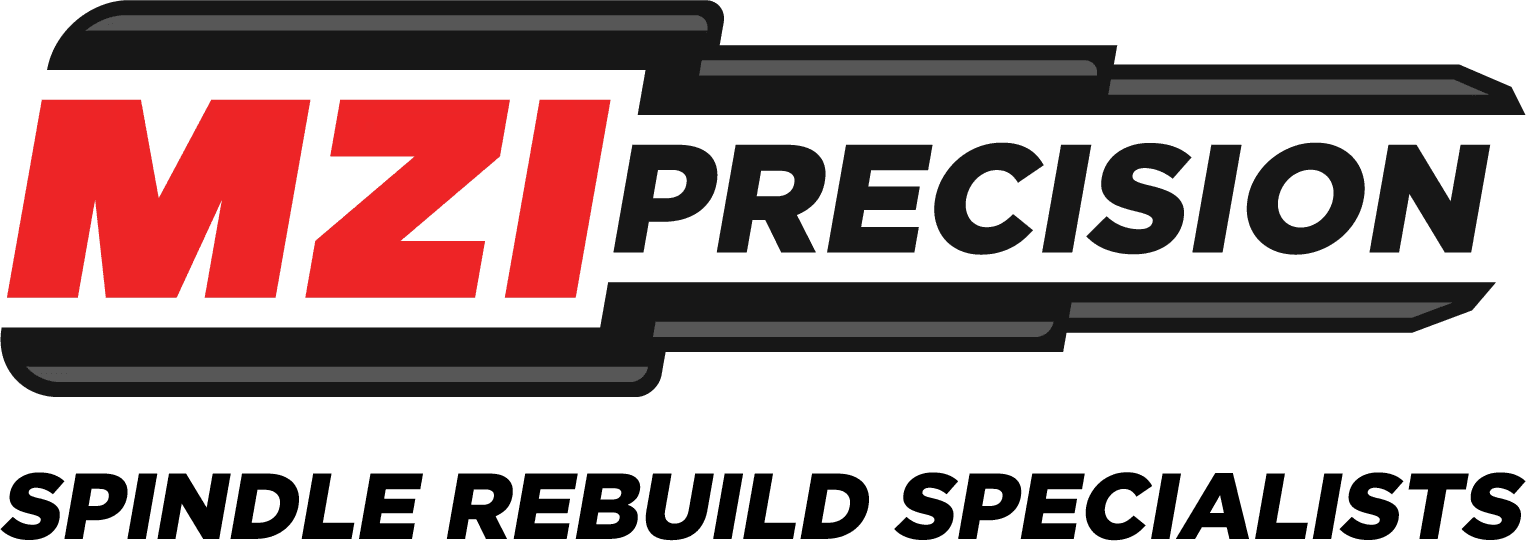Industrial manufacturing spindle replacement is crucial for maintaining the efficiency of manufacturing processes. When spindles start to wear out, they can lead to increased downtime, poor product quality, and heightened operational costs. Recognizing the importance of keeping spindles in peak condition ensures that manufacturing systems remain both productive and precise.
- Immediate Signs You Need a Replacement:
- Persistent noise or vibration
- Uneven or poor-quality outputs
- Increased operational costs
MZI Precision specializes in spindle repair and replacement, offering expert solutions custom for the aerospace and industrial landscapes. Their team of skilled engineers ensures that each spindle is restored or improved to meet or exceed its original performance benchmarks.
It’s more than just a technical upgrade—choosing to invest in the right spindle replacement improves manufacturing reliability and efficiency. MZI Precision’s commitment to quality ensures peak performance and minimizes operational disruptions.

Industrial manufacturing spindle replacement terms explained:
Understanding Deck Spindles
In industrial manufacturing, deck spindles are vital components that ensure machinery operates smoothly and efficiently. Understanding the different parts of a spindle assembly can help maintain and improve performance.
Spindle Assembly
The spindle assembly is the heart of the spindle system. It connects various components, allowing for precise rotation and power transfer. In industrial settings, a well-maintained spindle assembly is crucial for producing high-quality outputs with minimal downtime. The assembly typically includes the shaft, bearings, and housing, each playing a critical role in functionality.
Spindle Bearings
Bearings are perhaps the most critical part of the spindle assembly. They allow the spindle to rotate with minimal friction, ensuring smooth operation. Over time, bearings can wear out due to constant use and exposure to harsh conditions. Replacing worn or damaged bearings with high-quality options can prevent operational hiccups and extend the life of the spindle assembly.
Key Spindle Parts
Beyond the bearings, several other components are essential to the spindle’s operation:
- Shaft: This is the central component that rotates and transfers power. It’s crucial for the shaft to be perfectly aligned and free of defects to ensure smooth operation.
- Housing: Encloses the spindle components, providing protection and stability. A well-designed housing minimizes vibrations and supports the spindle during high-speed operations.
- Pulley System: Transfers power from the motor to the spindle, driving the rotation. Ensuring that the pulleys are correctly aligned and free from wear is essential for consistent performance.
Each of these components requires regular inspection and maintenance to keep the spindle assembly in optimal condition. Neglecting any part can lead to increased wear and tear, resulting in costly repairs and downtime.
By understanding these essential spindle parts, manufacturers can ensure their equipment operates efficiently, reducing the risk of unexpected failures and maintaining high production quality. Investing in reliable spindle components and regular maintenance can save time and money in the long run, ensuring that operations remain smooth and efficient.
Signs You Need an Industrial Manufacturing Spindle Replacement
Recognizing the signs that your industrial manufacturing spindle needs replacing can save you time and money. Here are key indicators to watch for:
Unusual Noises
One of the first signs of spindle trouble is unusual noises. If you hear grinding, whirring, or vibration noises, it’s a red flag. These sounds often mean something is off balance or worn out. For instance, grinding noises usually indicate metal-on-metal contact, often due to bearing failure. Bearings are crucial for smooth operation, and their failure can lead to more severe damage if not addressed promptly.
Vibration
Excessive vibration is another telltale sign. It can be caused by misalignment, worn bearings, or debris in the spindle. Vibration not only affects the spindle itself but can also lead to uneven wear on other machine components. Over time, this can escalate into more significant issues, affecting the entire machinery’s performance. Regular maintenance and immediate attention to vibration issues can prevent costly repairs down the line.
Uneven Cuts
If you’re noticing uneven cuts in your production output, the spindle might be the culprit. Uneven cuts often result from a spindle that isn’t rotating correctly, possibly due to misalignment or bearing issues. This not only affects the quality of the output but can also lead to increased material waste and reduced efficiency.

Addressing these signs early can prevent more severe problems and ensure your machinery continues to operate at peak efficiency. Regular inspections and maintenance are essential to catch these issues before they lead to significant downtime or costly repairs. If you notice any of these signs, it might be time to consult with professionals who can provide expert diagnosis and solutions.
Deck Spindle Replacement Process
Replacing an industrial manufacturing spindle might sound complicated, but breaking it down into simple steps can make it manageable. Let’s walk through the process, focusing on removing old bearings, spindle assembly, and deck removal.
Removing Old Bearings
The first step in industrial manufacturing spindle replacement is removing the old bearings. Bearings are critical for smooth spindle rotation. If they’re worn out, they can cause noise and vibration. To remove them:
- Power Down: Always turn off and disconnect the machine to ensure safety.
- Access the Bearings: Carefully disassemble the components around the spindle to expose the bearings. Take notes or pictures during this process to help with reassembly.
- Use a Bearing Puller: A bearing puller is the best tool for this job. It helps remove the bearings without causing damage to the spindle shaft. Avoid improvising with other tools, as this can lead to further damage.
- Clean the Area: Once the bearings are out, clean the spindle shaft and housing. Use a degreaser to remove old lubricant and debris. Ensure no residue remains by giving it a final wipe with isopropyl alcohol.
Spindle Assembly
After removing the old bearings, it’s time to focus on the spindle assembly. This is where the new bearings come in:
- Inspect the Spindle Shaft: Check for wear or damage. Use micrometers to ensure the shaft is within acceptable tolerance levels.
- Install New Bearings: Apply high-quality lubricants to the new bearings. This ensures smooth operation and reduces wear.
- Reassemble the Spindle: Carefully reassemble the spindle components, ensuring everything fits snugly and securely. Follow the notes or photos taken during disassembly for guidance.
Deck Removal
In some cases, the entire deck might need to be removed for easier access to the spindle. Here’s how to tackle this:
- Secure the Machine: Ensure the machine is stable and won’t move during the process.
- Remove Deck Fasteners: Locate and remove the fasteners that secure the deck to the machine. Keep these in a labeled container to avoid losing them.
- Lift the Deck: With the fasteners removed, carefully lift the deck away. This might require assistance, depending on the deck’s size and weight.
- Inspect the Deck: While the deck is off, inspect it for any signs of wear or damage that might affect spindle performance.
By following these steps, you can effectively replace the industrial manufacturing spindle, ensuring your machinery continues to run smoothly. Proper maintenance and timely replacement can prevent bigger problems and extend the life of your industrial equipment.
Benefits of Professional Industrial Manufacturing Spindle Replacement
Choosing professional services for industrial manufacturing spindle replacement offers numerous advantages, especially in industrial settings. Let’s dig into why expert intervention is crucial.
OEM Expertise
Professional services bring Original Equipment Manufacturer (OEM) expertise to the table. This ensures that the replacement parts are of the highest quality and compatibility with your machinery. OEM parts are designed to meet the exact specifications of the original components, ensuring optimal performance and longevity. This expertise is vital in maintaining the precision and efficiency of industrial machines, where even minor deviations can lead to significant issues.
Exceptional Service
Working with professionals means you benefit from exceptional service throughout the replacement process. Companies like MZI Precision prioritize customer satisfaction by providing detailed diagnostics, timely updates, and transparent communication. This level of service ensures that you are informed and confident in the repair process, reducing stress and uncertainty. Additionally, many professional services offer warranties on their work, giving you peace of mind and assurance of quality.
Industrial Applications
In industrial applications, the stakes are high. Machines must operate efficiently to meet production demands. Professional industrial manufacturing spindle replacement ensures that your equipment is in top condition, minimizing downtime and maximizing productivity. Expert technicians understand the unique demands of industrial environments and can provide custom solutions that address the specific needs of your machinery. This not only extends the lifespan of your equipment but also improves its performance, contributing to the overall success of your operations.
By opting for professional replacement, you safeguard your investment and ensure that your industrial machinery operates at its best. Next, we’ll address some frequently asked questions about industrial manufacturing spindle replacement, providing clarity on common concerns and misconceptions.
Frequently Asked Questions about Industrial Manufacturing Spindle Replacement
How to tell if an industrial manufacturing spindle is bad?
Identifying a bad industrial manufacturing spindle early can save you time and money. Listen for unusual noises like grinding or clunking sounds. These noises often indicate that the spindle bearings are worn out or damaged. Additionally, look for inconsistencies in your manufacturing processes. A spindle that is not rotating smoothly will cause variations in your work, leading to poor-quality outputs. If you notice these signs, it’s time to consider a replacement.
When should industrial manufacturing spindles be replaced?
Industrial manufacturing spindles should be replaced when they start making grinding sounds or clunking sounds during operation. These noises suggest that internal components are failing, which can lead to more severe issues if not addressed promptly. Regular inspections can help catch these problems early. If your spindle is not performing as expected or if you observe a decline in the quality of your work, it’s a clear indication that it’s time for a replacement.
Are all industrial manufacturing spindles the same?
Not all industrial manufacturing spindles are identical. There are various spindle types designed for specific industrial applications. For example, high-frequency spindles are used for precision tasks, while motorized spindles handle heavy-duty operations. Each type of spindle offers unique benefits and is suited for different tasks within manufacturing settings. Understanding the specific requirements of your application will help you choose the right spindle, ensuring optimal performance and efficiency in your industrial processes.
Conclusion
At MZI Precision, we understand the critical role that spindles play in the industrial manufacturing sector. Our expertise in spindle rebuilding ensures that your equipment operates at peak efficiency, minimizing downtime and maximizing productivity. We specialize in bringing worn-out spindles back to life, changing them from worn to wow with precision and care.
Our commitment to exceptional support sets us apart. From the moment you contact us, our team is dedicated to providing you with the best service possible. Whether it’s a custom spindle design or a complex rebuild, we have the knowledge and experience to meet your needs. Our goal is to exceed your expectations, ensuring your operations run smoothly and efficiently.
With a focus on quality and reliability, MZI Precision is your trusted partner for all your spindle needs. Explore our spindle bearing assembly services to find how we can assist you in achieving operational excellence. Let us help you optimize your spindle operations with our expertise and innovative solutions.



